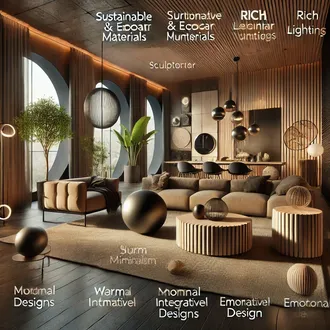Transcription Elements of decoration (1)
The knowledge of the sensations that can cause even the smallest details in the perception of the environment, allow the decorator to obtain infinite results from the use and combination of the different elements that make up the decoration. Through the intentional management of space, lines, shapes, light, color, texture, wallpaper, etc., the decorator manages to reinforce the atmosphere that the users of the decorated spaces wish to perceive.
Therefore, the decorator needs to know the sensations produced by the different ways of combining the decorative elements. For example: The predominance of blue-green tones in a room reinforces the sensation of coldness, while red tones reinforce the sensation of warmth.
The space
The space of the room, although it cannot be physically modified, is the first element to take into account when configuring the decorative idea. This is because depending on the length, width and height of the room, the decorator will select the objects that will allow him to provoke feelings of spaciousness, narrowness or balance.
Space can be divided into two categories: positive space and negative space. Positive space is that which is populated by objects, while negative space is that which is between objects and allows, among other things, the passage of light, air and the passage of people.
The prevalence of one of the two types of spaces in a room could help us to identify a decorative style, for example: in the minimalist style, the negative spaces are much higher than the positive ones, while in the eclectic style the opposite is true.
When distributing the spaces in a room, we must be careful to avoid overloading or depopulating the spaces too much.
The lines
The use of lines helps to create uniformity, contrast or harmony in the decoration. The predominance of one of the different types of lines (horizontal, vertical, slanted or curved) causes different sensations:
- Horizontal lines forming tables, shelves and other surfaces suggest restfulness, formality and efficiency. They are also used to make the room look wider; however, this effect can also cause a feeling of boredom.
- Vertical lines suggest strength, freedom, stability; their predominance gives the illusion of a taller room.
- The inclined or zigzag lines give the sensation of energy, movement, activity, they are captured quickly and capture our attention for much longer than the others. Excessive use of these lines can cause unwanted distractions.
- Curved lines suggest continuity, softness, naturalness, softness and sensuality.
Shape
The form intervenes in the appreciation of the room and of each of the objects that appear in it. The decorator can use two-dimensional shapes that are completely flat surfaces (rugs, paintings, carpets, etc.) and three-dimensional shapes that are volumetric objects (furniture, chests, vases, vases, etc.).
Shapes can also be classified as geometric, abstract and natural. Geometric and abstract shapes (rectangular, spherical, circular, pyramidal, undefined, etc.) are related to the artificial, while natural shapes (petals, leaves, animal figures, etc.), provide more organic and natural environments.
Harmony and balance can be achieved by using different objects of similar shapes; however, the use of many objects of different shapes generates confusion.
elements 1




